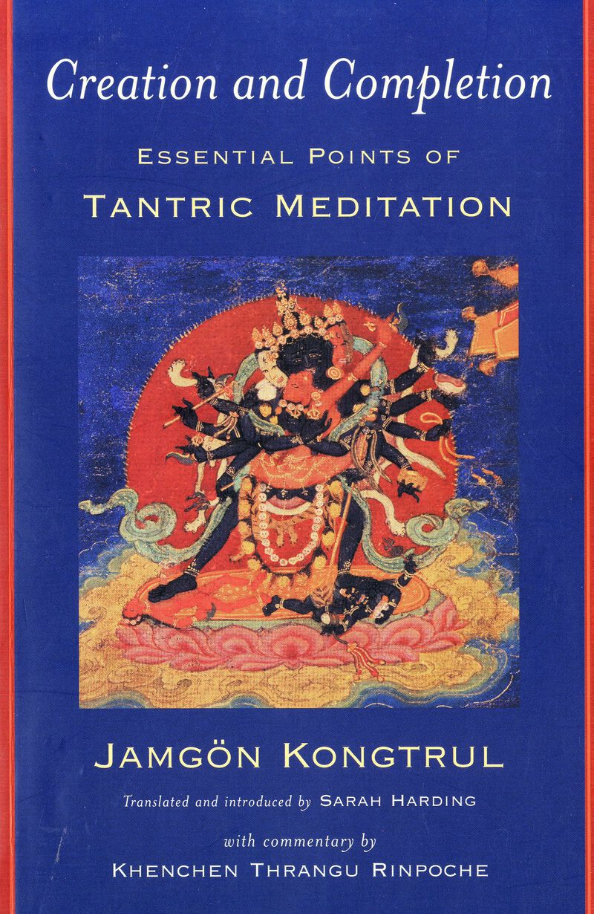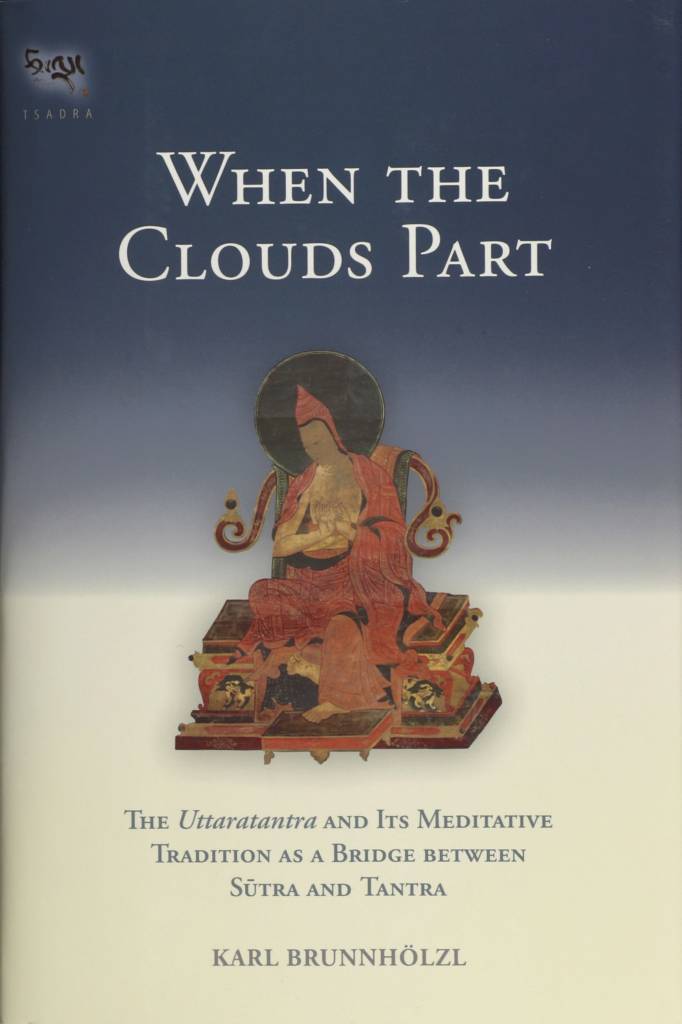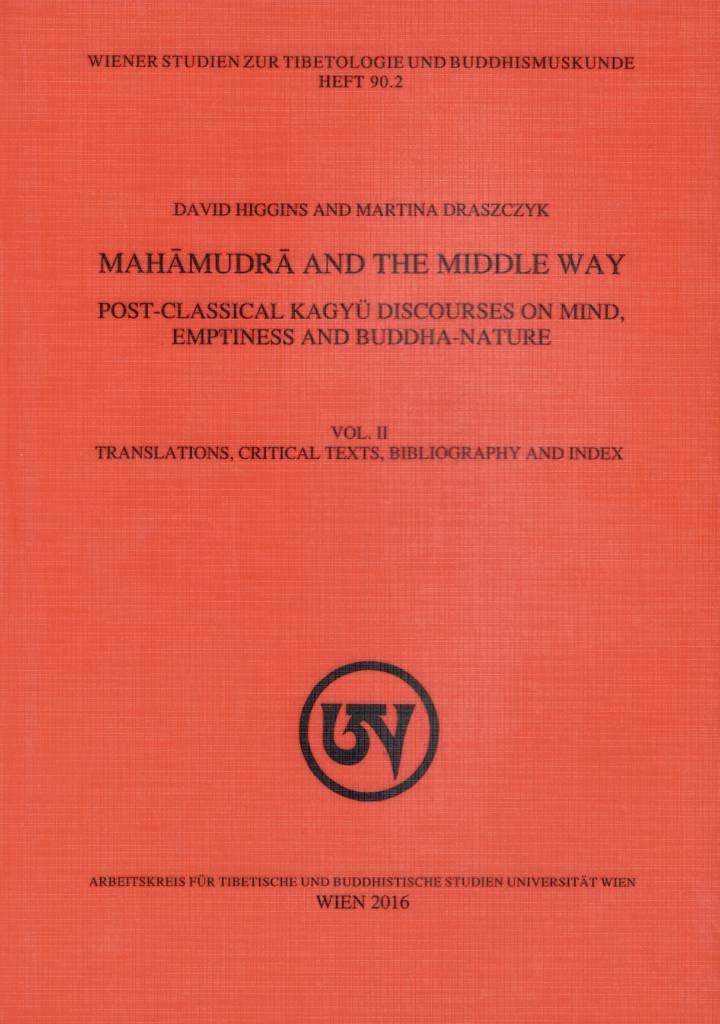Tantra and Buddha-Nature
Watch & Learn
In English with his direct, characteristic humor, Khenpo Rinpoche presents the "shining star" of buddha-nature in the minds of sentient beings as the same nature as the buddhas. He says, "We are always guided by this nature all the time whether we realize it or not."
From the Tantras
In the Hevajra Tantra, it states:
- सत्त्वा बुद्धा एव किं तु आगन्तुकमलावृताः
तस्यापकर्षनात् सत्त्वा बुद्धा एव न संशयः- །སེམས་ཅན་རྣམས་ནི་སངས་རྒྱས་ཉིད།
།འོན་ཀྱང་གློ་བུར་དྲི་མས་བསྒྲིབས།
།དེ་གསལ་ན་ནི་སངས་རྒྱས་ཉིད།- All beings are, themselves, buddhas.
However, this is obscured by adventitious stains.
When those are cleared away, buddhahood is actualized.~ Adapted from D.L. Snellgrove. The Hevajra Tantra: A Critical Study. London: Oxford University Press, 1959: p. 107.
In the Guhyagarbha Tantra, it states:
- །ཨེ་མའོ་བདེ་གཤེགས་སྙིང་པོ་ལས། རང་གི་རྣམ་རྟོག་ལས་ཀྱིས་སྤྲུལ།
- Ema ho, from the sugatagarbha
one's own discursive thinking manifests due to karma.~ Cited in Higgins, David. The Philosophical Foundations of Classical rDzogs chen in Tibet: Investigating the Distinction Between Dualistic Mind (sems) and Primordial Knowing (ye shes). Wien: Arbeitskreis für Tibetische und Buddhistische Studien, Universität Wien, 2013: p. 180.
From the Masters
Maitrīpa
In the first verse of his Tattavadaśaka, he states:
- सदसद्योगहीनायै तथतायै नमो नमः।
अनाविला यतः सैव बोधतो बोधिरूपिणी॥१॥- Homage to you, suchness,
Which has no association with existence and non-existence,
Because, [when] stainless, this very [suchness]
Has the form of enlightenment in virtue of realization.~ Mathes, Klaus-Dieter. A Fine Blend of Mahāmudra and Madhyamaka: Maitrīpa's Collection of Texts on Non-Conceptual Realization (Amanasikāra). Wien: Österreichischen Akademie Der Wissenschaften, 2015: p. 211.
Third Karmapa Rangjung Dorje
The Third Karmapa concludes his The Treatise on Pointing Out the Tathāgata Heart with the following lines:
- །འགྲོ་ཀུན་སངས་རྒྱས་སྙིང་པོ་འདི།
།མཐར་ཕྱིན་མ་ནོར་ཤེས་པར་ཤོག
།སངས་རྒྱས་ཀྱི་སྙིང་པོ་གཏན་ལ་དབབ་པ་རྡོ་རྗེ་ཐེག་པའི་སྙིང་པོ་རྫོགས་སོ།།- May all beings know this buddha heart
Perfectly and without error!
This completes the determination of the buddha heart,
The essence of the vajrayāna.~ rang byung rdo rje, (Karmapa, 3rd). de bzhin gshegs pa'i snying po bstan pa'i bstan bcos. In gsung 'bum rang byung rdo rje. Zi ling: mtshur phu mkhan po lo yag bkra shis, 2006: Vol. 7, p. 290.
-Translation from Karmapa, The Third, Rang byung rdo rje. Luminous Heart: The Third Karmapa on Consciousness, Wisdom, and Buddha Nature. Translated by Karl Brunnhölzl. Nitartha Institute Series. Ithaca, NY: Snow Lion Publications, 2009: p. 360.
Gö Lotsāwa Zhönu Pal
Gö Lotsāwa on the origins of the Tibetan exegesis of the Ratnagotravibhāga:
- With regard to the [Maitreya works], three among the works of the Illustrious Maitreya, [namely] the Abhisamayālaṁkāra, the Mahāyānasūtrālaṁkāra, and the Madhyāntavibhāga, were translated by the translators Paltseg (Dpal brtsegs), Yeshé Dé (Ye shes sde), and others during the first period of the spread of the doctrine [in Tibet]. As for the [remaining] two, the [Ratnagotravibhāga Mahāyāna-]Uttaratantra[śāstra] and the Dharmadharmatāvibhāga together with its commentary, Lord Maitrīpa saw light shining from a crack in a stūpa and, wondering what the source of the light was, tried to determine it. As a consequence, he obtained the texts of the two treatises. He rejoiced [in them] and prayed to the venerable [Maitreya], whereupon he arrived—directly visible in an opening between clouds—and duly bestowed [on Maitrīpa] the "oral transmission" (lung) [of both texts]. Thus it is known.
- Then he who is called Paṇḍita Ānandakīrti heard [the teaching of both texts] from Lord Maitrīpa and carried the texts to Kashmir disguised as a beggar. Upon his arrival, the great paṇḍita Sajjana recognized him as a scholar and invited him to his home. [Sajjana] listened to [the teaching of] both treatises and copied the texts. The great translator Loden Sherab heard them [from Sajjana], translated them in Śrīnagar in Kashmir, and composed an extensive explanation in Tibet.
- Also, the [well-] known Tsen Kawoché, a disciple of Drapa Ngönshé, came with the great translator (i.e., Ngog Loden Sherab) to Kashmir. He requested Sajjana to bestow on him [the Maitreya works] along with special instructions, since he wanted to make the works of the Illustrious Maitreya his "practice [of preparing] for death" ('chi chos). Thereupon [Sajjana] taught all five works, with Lotsāwa Zu Gawa Dorjé serving as translator. He also gave special instructions with regard to the Uttaratantra in the due way, and back in Tibet, Tsen explained it to numerous [spiritual friends] in Ü and Tsang. The translator Zu Gawa Dorjé wrote a commentary on the Uttaratantra in accordance with the teaching of Sajjana, and translated the [Dharma]dharmatāvibhāga, both root-text and commentary. Thus neither the Uttara[tantra] nor the [Dharma]dharmatāvibhāga was spread in India before the time of Lord Maitrīpa. Neither is found in the great treatises such as the Abhisamayālaṁkārāloka, not even "a single phrase of them" (zur tsam).
~ Klaus-Dieter Mathes. A Direct Path to the Buddha Within: Go Lotsāwa's Mahāmudrā Interpretation of the Ratnagotravibhāga. Studies in Indian and Tibetan Buddhism. Boston:Wisdom Publications, 2008: pp. 161-163.
Śākya Chokden
In the opening lines of his Undermining the Haughtiness of Others by the Wheel of Brahma: A Treatise Clarifying Mahāmudrā Śākya Chokden states:
- རང་བཞིན་རྣམ་དག་རྫོགས་སངས་རྒྱས་ཀྱི་བློ།
།གློ་བུར་དྲི་མའི་ཚོགས་དང་མ་འདྲེས་པ།
།དུས་རྣམས་རྟག་ཏུ་ཀུན་ལ་བཞུགས་གྱུར་པ།
།གཡོ་མེད་ཕྱག་རྒྱ་ཆེ་ལ་ཕྱག་འཚལ་ནས།- I pay homage to the unwavering mahāmudrā,
The naturally pure perfect buddha-mind—
Unadulterated by the host of adventitious stains—
That has been ever-present in all for all time.~ shAkya mchog ldan. phyag rgya chen po gsal bar byed pa'i bstan bcos tshangs pa'i 'khor los gzhan blo'i dregs pa nyams byed. In gser mdog paN chen shAkya mchog ldan gyi gsung 'bum. rdzong sar: rdzong sar khams bye'i slob gling thub bstan dar rgyas gling, 2006-2007: Vol. 17, p. 438.
-David Higgins and Martina Draszczyk. Mahāmudrā and the Middle Way: Post-Classical Kagyü Discourses on Mind, Emptiness and Buddha-Nature. Volume 2: Translations, Critical Texts, Bibliography and Index. Wiener Studien zur Tibetologie und Buddhismuskunde 90. Vienna: Arbeitskreis für Tibetische und Buddhistische Studien Universität Wien, 2016: p. 14.
Eighth Karmapa Mikyö Dorje
In his commentary on the Madhyamakāvatāra, the Eighth Karmapa states:
- ཕྱག་རྒྱ་ཆེན་པོའི་ཆོས་ཚུལ་འདིའི་མྱོང་ཁྲིད་འདེབས་པ་ལ་མཛད་པ་ལ་གསང་སྔགས་ཀྱི་དབང་བསྐུར་བ་ཡང་མི་མཛད་ལ། ཕྱག་ཆེན་འདིའི་དངོས་བསྟན་མདོ་ལུགས་ཀྱི་སྤྲོས་བྲལ་སྟོང་པ་ཉིད་ཀྱི་དབུ་མ་དང། ཤུགས་ལས་མདོ་སྔགས་ཀྱི་ཟབ་དོན་མཐར་ཐུག་བདེ་གཤེགས་སྙིང་པོ་ཐུན་མོང་དང་ཐུན་མོང་མིན་པའང་སྟོན་པ་ལ་
- In this Mahāmudrā teaching method, experiential instructions (myong khrid) may be given without Secret Mantra empowerments first being bestowed. Rather, the principal teaching of this Mahāmudrā is the Madhyamaka of emptiness free from elaborations belonging to the Sūtra tradition. And, implicitly, it teaches ordinary and extraordinary buddha nature, the final profound meaning of the sūtras and tantras.
~ Mi bskyod rdo rje. Dbu ma la 'jug pa'i mam bshad dpal Idan dus gsum mkhyen pa'i zhal lung dwags brgyud grub pa'i shing rta. Gangtok: Rumtek Monastery, 1974: pp. 13–14.
-David Higgins and Martina Draszczyk. Buddha Nature Reconsidered: The Eighth Karma pa's Middle Path. Vol. 1: Introduction and Analysis. Vienna: Arbeitskreis für Tibetische und Buddhistische Studien Universität Wien, 2019: pp. 53-54.
Pema Karpo
Among the two, buddha nature and adventitious stains, buddha nature is luminous dharmakāya because it is genuine coemergent spontaneity, indomitable and imperishable supremejoy, encompassing like the sky. Adventitious stains are mind and mental factors of the three realms, together with the breath movements [that fuel them], which have not eliminated the latent tendencies for transmigration.
[...]
In this way, dharmakāya, the ground that is free from stains, is naturally present potential, the expanse of reality that is thoroughly devoid of having all aspects, like a preexistent great treasure.~
-David Higgins and Martina Draszczyk. Mahāmudrā and the Middle Way: Post-Classical Kagyü Discourses on Mind, Emptiness and Buddha-Nature. Volume 2: Translations, Critical Texts, Bibliography and Index. Wiener Studien zur Tibetologie und Buddhismuskunde 90. Vienna: Arbeitskreis für Tibetische und Buddhistische Studien Universität Wien, 2016: p. 159-160.
Tsele Natsok Rangdrol
On the correlation of various terms Tsele Natsok Rangdrol states:
- །རང་བྱུང་རང་ཤར་རང་རིག་ཆོས་ཉིད་དོན། །འདི་ལ་མིང་གི་རྣམ་གྲངས་སྣ་ཚོགས་ཏེ། །ཕར་ཕྱིན་ཐེག་པར་ཆོས་ཉིད་བདེན་པ་ཟེར། །སྔགས་ཀྱི་ཐེག་པ་རང་བཞིན་འོད་གསལ་ཟེར། །སེམས་ཅན་དུས་ན་བདེར་གཤེགས་སྙིང་པོའི་ཁམས། །ལམ་གྱི་སྐབས་སུ་ལྟ་སྒོམ་ལ་སོགས་མིང། །འབྲས་བུའི་དུས་ན་སངས་རྒྱས་ཆོས་སྐུ་ཟེར། །དེ་སོགས་མིནད་དང་དབྱེ་བ་དུ་མ་ཡང་། །དོན་ལ་ད་ལྟའི་ཐ་མལ་ཤེས་པ་འདིའོ།
- This self-existing and self-manifest natural awareness, your basic state,
Has a variety of names:
In the Prajnaparamita vehicle it is called innate truth.
The vehicle of Mantra calls it natural luminosity.
While a sentient being it is named sugata-garbha.
During the path it is given names which describe the view, meditation, and so forth.
And at the point of fruition it is named the dharmakaya of buddhahood.
All the different names and classifications
Are nothing other than this present ordinary mind.~ rtse le sna tshogs rang grol. nges don gyi lta sgom nyams su len tshul ji lta bar ston pa rdo rje'i mdo 'dzin. In rtse le sna tshogs rang grol gyi gsung gdams zab phyogs bsgrigs. Kathmandu: Khenpo Shedup tenzin and Lama Thinley namgyal, 2007: pp.13-14.
-Tsele Natsok Rangdrol. The Heart of the Matter: The Unchanging Convergence of Vital that Show Exactly How to Apply the View and Meditation of the Definitive Meaning. Translated by Erik Pema Kunsang. Kathmandu: Rangjung Yeshe Publications, 2002: p. 14.
Chogyur Lingpa
In his treasure revelation the Lamrim Yeshe Nyingpo it states:
- ཤེས་བྱའི་གཞི་ནི་ཀུན་ཁྱབ་བདེ་གཤེགས་སྙིང༔
འདུས་མ་བྱས་པ་གསལ་སྟོང་རིག་པའི་བབས༔
འཁྲུལ་གྲོལ་ལས་འདས་མཁའ་ལྟར་རབ་ཏུ་ཞི༔
འཁོར་འདས་དབྱེ་བསྲི་མེད་པར་གནས་གྱུར་ཀྱང༔- The ground to be understood is the all-pervasive sugata essence
Uncompunded, luminous, and empty, it is the natural state of awareness.
Beyond confusion and liberation, it is completely quiescent, like space.
Although it abides without separation in samsara or joining in nirvana...~ mchog gyur gling pa. bla ma'i thugs sgrub rdo rje drag rtsal las zhal gdams lam rim ye shes snying po. In In Rin chen gter mdzod chen mo pod drug bcu re bzhi pa (The Great Treasury of Rediscovered Teachings Volume 64) by 'jam mgon kong sprul, 887-1167. New Delhi: Shechen Publications, 2007-2016.
-Padmasambhava, Jamgön Kongtrül, Kunsang, Erik Pema, trans. The Light of Wisdom Vol. 1. Hong Kong: Rangjung Yeshe Publications, 1999: p. 9.
Jamgön Kongtrul
In his commentary to the Lamrim Yeshe Nyingpo Jamgön Kongtrul states:
- ཤེས་བྱ་ཐམས་ཅད་ཀྱི་གཞིར་གྱུར་པ་ནི་སྣོད་བཅུད་ཀྱི་དངོས་པོ་ལ་ནམ་མཁས་ཁྱབ་པ་བཞིན་དུ་འཁོར་འདས་ཀུན་ལ་ཁྱབ་པའི་བདེ་གཤེགས་སྙིང་པོ་ཞེས་བྱ་བ་ཁྱད་པར་ལྔ་ལྡན་དུ་བཞུགས་པ་ཡིན་ཏེ། ངོ་བོ་འདུས་མ་བྱས་པ། བཞུགས་ཚུལ་གསལ་སྟོང་རིག་པའི་རང་བབས། དང་པོར་འཁྲུལ་མ་མྱོང་ཞིང་མཐར་གྲོལ་བ་ལས་འདས་པ། ནམ་མཁའ་ལྟར་སྐྱེ་འགག་སོགས་སྤྲོས་པའི་མཚན་མ་མེད་པས་རབ་ཏུ་ཞི་བ། འཁོར་བ་དང་མྱང་འདས་གཉིས་ལ་སྐྱོན་རྟོག་གིས་དབྱེ་ཞིང་རིང་བ་དང་། ཡོན་ཏན་དུ་ཤེས་པས་བསྲི་བ་སྟེ་ཉེ་བར་གྱུར་པ་གང་ཡང་མེད་པར་བཞུགས་ཤིང་གནས་པར་གྱུར་ཏོ། །ཀྱང་ཞེས་པ་ནི་ཚིག་ཕྱི་མ་སྡུད་པའི་སྒྲའོ།
- These appearances of the three existences (the container that is the outer world and the [inner] content [of sentient beings]), just as a face’s being transferred [as a reflection] into a mirror, appear as the magical display of inner nāḍīs, vāyus, and tilakas, and these three abide as the aspects of "the other"—the circle of the supreme maṇḍala
~ 'Jam mgon kong sprul. bla ma'i thugs sgrub rdo rje drag rtsal las zhal gdams lam rim ye shes snying po'i 'grel pa ye shes snang ba rab tu rgyas pa. In In Rin chen gter mdzod chen mo pod drug bcu re bzhi pa (The Great Treasury of Rediscovered Teachings Volume 64) by 'jam mgon kong sprul, 887-1167. New Delhi: Shechen Publications, 2007-2016.
-Padmasambhava, Jamgön Kongtrül, Kunsang, Erik Pema, trans. The Light of Wisdom Vol. 1. Hong Kong: Rangjung Yeshe Publications, 1999: p. 69.
In his Guiding Instructions on the View of Great Shentong Madhyamaka—Light Rays of the Stainless Vajra Moon Jamgön Kongtrul states:
- །ཕྱི་འཇིག་རྟེན་སྣོད་བཅུད་སྲིད་པ་གསུམ་གྱི་རྣམ་པར་ཤར་བ་འདི་དག་བཞིན་གྱི་བྱད་མེ་ལོང་ལ་འཕོས་པ་བཞིན་དུ་ནང་རྩ་རླུང་ཐིག་ལེའི་ཆོ་འཕྲུལ་དུ་ཤར་བ་ཡིན་ཞིང་དེ་གསུམ་ཡང་གཞན་མཆོག་དཀྱིལ་འཁོར་གྱི་འཁོར་ལོ་རྟེན་དང་བརྟེན་པར་བཅས་པའི་རྣམ་པར་བཞུགས་ལ། དེ་ཐམས་ཅད་ཀྱང་། དེ་ཁོ་ན་ཉིད་བདེ་གཤེགས་སྙིང་པོའ་རང་འོད་རང་མདངས་ཆོས་ཀྱི་སྐུ་ཉིད་རྣམ་པ་ཐམས་ཅད་པར་ཤར་བ་མཆོག་ཏུ་མི་འགྱུར་བའི་ཡེ་ཤེས། །དོན་དམ་ཆོས་ཀྱི་དབྱིངས་བདེ་སྟོང་ཟུང་འཇུག་རང་བཞིན་འགྱུར་བ་མེད་ལ་རྒྱུན་མི་ཆད་པས་རྒྱུད་ཀྱི་དོན་དུ་གསུངས་ཤིང་། དེའང་གཞིའི་གནས་སྐབས་དྲི་བཅས་དེ་བཞིན་ཉིད་ལ་རྒྱུའི་རྒྱུད་དང་། ལམ་དུས་ཆོས་ཉིད་དོན་ནི་རིམ་པར་སྣང་བ་ལ་ལམ་ཐབས་ཀྱི་རྒྱུད་དང་། དག་པ་གཉིས་ལྡན་མངོན་དུ་འགྱུར་བ་ན་ཤིན་ཏུ་རྣམ་དག་འབྲས་བུའི་རྒྱུད་ཅེས་བྱ་སྟེ། ལྟ་བ་ཐུན་མོང་མ་ཡིན་པ་དེ་ཉིད་ཀུན་རྫོབ་ཀྱི་སྟོང་ཚུལ་ལ་མཆོག་ཏུ་འཛིན་པ་རྣམས་ཀྱིས་ཕྱོགས་ཙམ་མི་མཐོང་བ་ལྟ་ཅི་སྨོས། གོང་སྨོས་མདོ་ལུགས་རང་རྐང་གི་ལམ་དེས་ཀྱང་ཡུན་རིང་པོར་འགོར་བ་ཡིན་པས། དབང་དང་དམ་ཚིག་གིས་ཁྱད་པར་དུ་བྱས་པའི་སྔགས་ཀྱི་ལམ་མཐའ་དག་ལས་ཁྱད་པར་དུ་འཕགས་པ་རྡོ་རྗེའི་རྣལ་འབྱོར་ཡན་ལག་དྲུག་ལ་མཉམ་པར་བཞག་པ་ན་དུས་ཐུང་ངུར་ཚེགས་ཆུང་ངུས་བདེ་བླག་ཏུ་རྟོགས་པར་འགྱུར་བ་ཡིན་ནོ།
- These appearances of the three existences (the container that is the outer world and the [inner] content [of sentient beings]), just as a face’s being transferred [as a reflection] into a mirror, appear as the magical display of inner nāḍīs, vāyus, and tilakas, and these three abide as the aspects of "the other"—the circle of the supreme maṇḍala with its support and supported. All of these are true reality’s—the sugata heart’s—own light and own radiance, the dharmakāya itself appearing as all aspects, and utterly changeless wisdom. This ultimate dharmadhātu, the union of bliss and emptiness, is unchanging in nature yet uninterrupted. Therefore, it is taught as having the meaning of "tantra." Being the stained suchness during the phase of the ground, it is [called] "the causal tantra." Since this actuality of the nature of phenomena appears gradually during the time of the path, it is [also called] "the path [or] method tantra." When it has manifested as being endowed with twofold purity, it is called "the tantra of the completely pure fruition." Let alone that those who cling to the manner of the seeming’s being empty as being supreme do not even see a fraction of this uncommon view, it takes a long time [to realize this view] even through the above-mentioned path of the sūtra system as it stands on its own feet. Therefore, when you rest in meditative equipoise in the six-branch vajra yoga that is more eminent than all [other] paths of mantra specified by empowerments and samayas, [this view] will be realized conveniently in a short time and with little hardships.
~ 'Jam mgon kong sprul. Gzhan stong dbu ma chen po'i lta khrid rdo rje zla ba dri ma med pa'i 'od zer. In Blo gros mtha' yas pa'i mdzod. Deb phreng drug pa. 'Khor lo tha ma'i dgongs don gces btus, 179–204. Kathmandu: Rigpe Dorje Publications, 2008: pp. 196-197.
Translation from Karl Brunnhölzl. When the Clouds Part: The Uttaratantra and its Meditative Tradition as a Bridge between Sūtra and Tantra. Boston: Snow Lion Publications, an imprint of Shambhala Publications, 2014: p. 847.
Thrangu Rinpoche
The Uttara Tantra belongs mainly to the sutra classification, the Third Turning of the Wheel of Dharma, because the text contains sections concerning the view, path, and fruition as well as many other topics. In combination, they are classified as sutra because the word 'sutra' literally means 'confluence' or 'that which has many parts gathered together.' Since it emphasizes the enlightened essence, the sugatagarbha, and because it is inseparable from the very basis of Mahamudra, this teaching is considered of great importance in the Kagyu tradition.~ Thrangu Rinpoche. Buddha Nature: Ten Teachings on the Uttara Tantra Shastra. Hong Kong: Rangjung Yeshe, 1988: p. 16.
The root of the wisdom that arises in Mahamudra is buddha nature, or buddha essence,
[...]
Buddha nature is realized through listening, contemplating, and meditating. This is the explanation according to the Sutra path. In terms of the Mahamudra path, realization occurs through the combination of the blessing of a true teacher and the arising of devotion within the pupil; through the combination of these two, buddha nature, the nature of the mind, manifests. Jamgon Kongtrul says buddha nature is realized either through the Sutra path of listening, contemplating, and meditating or through blessing and devotion of the Mahamudra path.~ Thrangu Rinpoche. On Buddha Essence: A Commentary on Rangjung Dorje's Treatise. Translated by Peter Alan Roberts. Boston: Shambhala Publications, 2006: p. XXI and p. 133.
The Kagyu masters of the past as an instruction called this the ordinary mind, or the natural state. They called it this out of their experience. This ordinary mind itself is the dharma expanse and the essence of the buddhas: it is our buddha nature. This is exactly what the term means; this is what we need to experience and recognize.~ Thrangu Rinpoche. Vivid Awareness: The Mind Instructions of Khenpo Gangshar. Translated by David Karma Choephel. Boston: Shambhala Publications, 2011: p. 124.
Further Readings
[Creation and Completion (2002)]
In the creation stage, practitioners visualize themselves in the form of buddhas and other enlightened beings in order to break down their ordinary concepts of themselves and the world around them. This meditation practice prepares the mind for engaging in the completion stage, where one has a direct encounter with the ultimate nature of mind and reality.
[When the Clouds Part]
As stated before, texts such as CMW, those by Mönlam Tsültrim, GC, the Eighth Karmapa’s Lamp, and GISM all establish connections between the Uttaratantra and Mahāmudrā. Such connections are also found in a number of Indian and Tibetan Mahāmudrā works. Usually, these connections are made in the wider context of the Mahāmudrā approaches that came to be called "sūtra Mahāmudrā" or "essence Mahāmudrā" (the Mahāmudrā approach that is beyond "sūtra Mahāmudrā" and "tantra Mahāmudrā"). In order to provide some background against which the Uttaratantra-based Mahāmudrā instructions in the above texts can be appreciated more fully, I will next present an overview of the key elements of the different approaches to Mahāmudrā, their origins, their scriptural sources, and the different ways in which they are taught.
[Mahāmudrā and the Middle Way]
This two-volume publication explores the complex philosophy of Mahāmudrā that developed in Tibetan Dwags po Bka’ brgyud traditions between the 15th and 16th centuries CE. It examines the attempts to articulate and defend Bka’ brgyud views and practices by four leading post-classical thinkers: (1) Shākya mchog ldan (1423‒1507), a celebrated yet controversial Sa skya scholar who developed a strong affiliation with the Karma Bka’ brgyud Mahāmudrā tradition in the last half of his life, (2) Karma phrin las Phyogs las rnam rgyal (1456‒1539), a renowned Karma Bka’ brgyud scholar-yogin and tutor to the Eighth Karma pa, (3) the Eighth Karma pa himself, Mi bskyod rdo rje (1507‒1554), who was among the most erudite and influential scholar-hierarchs of his generation, (4) and Padma dkar po (1527‒1592), Fourth ’Brug chen of the ’Brug pa Bka’ brgyud lineage who is generally acknowledged as its greatest scholar and systematizer.
[[|Book: Buddha Nature Reconsidered]]
As a Mahāmudrā proponent, Mi bskyod rdo rje gives primacy to innate modes of being and awareness, such as coemergent wisdom or buddha nature naturally endowed with qualities, that are amenable only to direct yogic perception and revealed through the personal guidance of a qualified teacher. As an exponent of yuganaddha (zung ’jug), i.e., unity (literally, “yoking together”), he espouses the tantric goal of unity beyond extremes, a goal grounded in the inseparability of the two truths or realities (bden gnyis dbyer med), of appearance and emptiness (snang stong dbyer med). In his eyes, this unity is only fully realized when one understands that the conventional has no independent existence apart from the ultimate and that the latter is a condition of possibility of the former. As an advocate of apratiṣṭhāna (rab tu mi gnas pa), i.e., nonfoundationalism, he resolutely maintains that all outer and inner phenomena, including deep features of reality disclosed through meditation, lack any ontic or epistemic essence or foundation that the mind can lay hold of. Finally, as a champion of Madhyamaka, i.e., the Buddhist Middle Way, the author attempts to ply a middle course between the extremes of existence and nonexistence, eternalism and nihilism. These various doxographical strands are deftly interwoven in the Karma pa’s view of buddha nature, which affirms the innate presence of buddha nature and its qualities in all sentient beings as well as their soteriological efficacy while denying either any ontological status.




